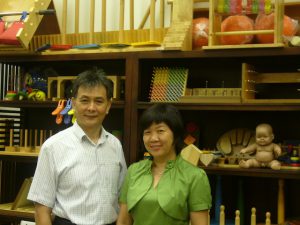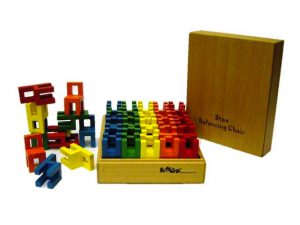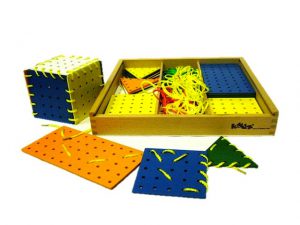Child’s play
These toys are not just for kids but also for those with dementia.
BY: Eleanor Yap
Gary Seow and Carrie Chan started out selling and designing educational toys for children under their company Kydz out of their shop at E-Centre@Redhill. However, now they are looking at the other end of the age spectrum – the elderly, in particular those with dementia. The husband-and-wife team shared that currently there is no company in Singapore that caters to this specific group and feels strongly that this group could use some stimulating toys and games to enhance their quality of life.
Currently, there are 35.6 million people worldwide with dementia and this number is expected to double by 2030. In Singapore, the numbers are just as dismal – currently there are about 28,000 elderly aged 60 years and above with dementia and this is expected to more than double to 80,000 by 2030. Seeing these figures, Seow and Chan may just be onto something.
“For elderly, playing with toys is a form of mixing therapy with fun. It helps increase both their sense of freedom and confidence, thus leading to a fulfilling and healthy life,” explained Seow, 52, a former sales and logistics manager.
Their elderly foray
It all started in 2009 when Changi General Hospital (CGH) visited Kydz’s booth at an exhibition for kids and asked them to develop something for the elderly. The project took the shape of a toolkit for caregivers who work with dementia patients and included a bag filled with 42 activities – games for cognitive, reminiscing and vision, art therapy and much more.
Shared 47-year-old Chan, who worked as a regional merchandising manager for 15 years before starting Kydz: “We had to source for the items as well as tailor-made some of them. We also had to consolidate them and pack them.”
They worked closely with a team of occupational therapists from CGH who shared what items would work and what wouldn’t – concerns like too big, too heavy or couldn’t be held. After nine months back and forth, the project was launched in 2011 with CGH passing out a number of the bags to caregivers. (The recipients of the toolkits are members of the public who attend the caregivers’ training organised by the CGH. The toolkits are available to them at a subsidised rate.) However, the project continues to be a work in progress with feedback still coming in and improvements being made to the items.
“At the time, we were also getting people coming to our store and enquiring about products for grandparents or older parents with dementia,” said Chan. It was then that they decided it was time to do something beyond the CGH project. Last year, they introduced a range of products for those with dementia and this year, Seow and Chan took it one step further and named the range of toys and resources – CARE (Creative Aids & Resources for the Elderly), with a logo of a bamboo “symbolising strength, longevity, grace, peace, flexibility, humility, good health and the ability to cope with adversity”.
“We felt that without a name distinction between our kids’ and elderly ranges, we might offend those who want to buy the products for their parents with dementia if we said it is a kids’ range. They might say my father is grown man, why give him something that is for the kids? We needed to be more sensitive.”
The range, which provides cognitive stimulation, carries more than 120 products, with some overlapping into Kydz’s children’s range. The range includes toys and games such as threading beads, arts and craft sets, Stax Balancing Chair, puzzles, fidget balls, puppets, dolls, Montessori toys and many more. They also offer larger items like multi-functional stairway assembled with blocks, shoulder uplifting exercise rack, etc. CARE ranges from as low as S$4 to S$80. Some of the items from the CARE range is imported from countries like the US, Israel, UK, Thailand, Vietnam, Indonesia and China, while some are designed by the couple, thanks the lessons they learned from their CGH project.
Challenges
Since their range launched, they have found that some people are still hesitant in purchasing the products for their loved ones with dementia. “When buying for their kids, the parents usually are more than willing to spend but when buying for someone with dementia, they would consider and re-consider. If the product would make their child smart and it was their only child, they would buy.
“There is still an aversion of using toys for their parents with dementia as they would say – “Are you sure or not?”” said Chan. “At some level it may be disturbing for a family to see their mom or dad playing with toys, or some family members believe toys are not meant for adults who have lived full and accomplished lives. It is a mindset issue.”
Beyond catering to their retail customers, they also supply more than a 100 of their CARE range to the various senior activity centres, nursing homes and hospitals in Singapore.
“Seventy percent of our clientele includes the senior centres and hospitals. However, the number of individuals coming to purchase is rising. They are family members who find us through word-of-mouth as well as ads.” To continue getting the word out on their company and products, Seow and Chan have exhibited at a number of senior-related exhibitions including LivEnabled Week 2011, World Alzheimer’s Day 2011, 50plus Expo 2012, and Annual Singapore Conference on Ageing (ASCA) 2012.
Despite the challenges they face, there are some moments that they will not forget, including when a older man came into the store with his son to pick out a CARE product for his wife with dementia. Chan shared: “It was a touching moment to see both of them pick the product. The son would ask his father when he found a product – “Do you think mom would like this?” And the father would say: “No, she would prefer alphabets to numbers.””




I’ve been working with Gary for 2 years, and his professionalism i can guarantee.
Thanks for your comment.
I wish that more people could understand the value of toys for the elderly – to them it brings activity and a better quality of life.